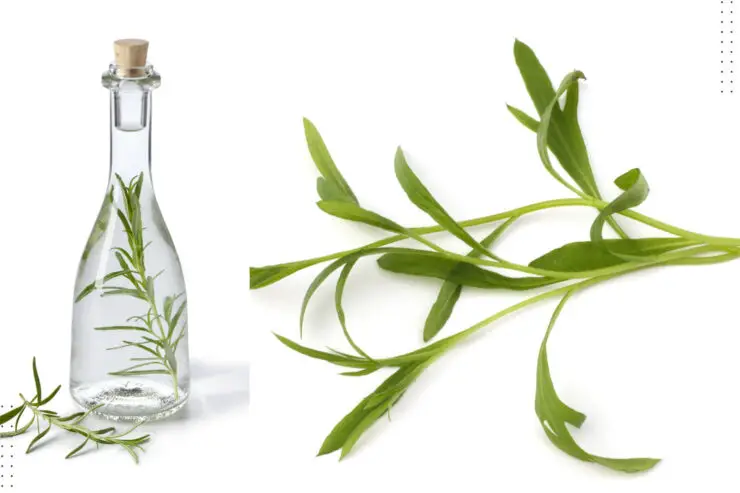As an Amazon Associate I earn from qualifying purchases. Please read the disclaimer for more info.
Are you making a recipe that calls for a tablespoon of tarragon vinegar but you don’t know where to find it or want something else to spice up your dish? No problem – here we look at the best substitutes for tarragon vinegar to add the flavor you want.
Let’s jump right in with each tarragon vinegar substitute explained and the best way they can be used to enhance your cooking.
What is Tarragon Vinegar?
Tarragon vinegar is a versatile condiment that dates back to the 18th century.
It infuses tarragon stems, leaves, and sometimes flowers into a white wine or champagne vinegar.
The result is a slightly sweet yet tangy vinegar with an anise flavor, making it a great addition to salads and sauces.
Its unique flavor profile can elevate other recipes, such as marinades, vinaigrettes, or cocktails.
It is often used in French cuisine.
Best Substitutes For Tarragon Vinegar
Several options are available if you’re looking for a tarragon vinegar substitute. White wine vinegar and champagne vinegar are great substitutions as they are usually used as the base for the original.
Sherry vinegar is another popular replacement made from sherry wines and has a more intense flavor than the dry white wine vinegar variety.
You can also try substituting rice vinegar with a mellow taste and a pleasant mix of sweetness and acidity, ideal for salad dressings and salads.
Furthermore, apple cider vinegar works especially well in light sauces, where its fresh and tart flavor can truly come alive.
Both blackberry and red raspberry vinegar have sweet and fruity flavors that offer interesting additions to many dishes.
These alternatives to tarragon vinegar can be used for creating vinaigrettes or marinades.
Still, depending on which substitution you use, the finished product will have its own unique taste, texture, and aroma!
White Wine Vinegar
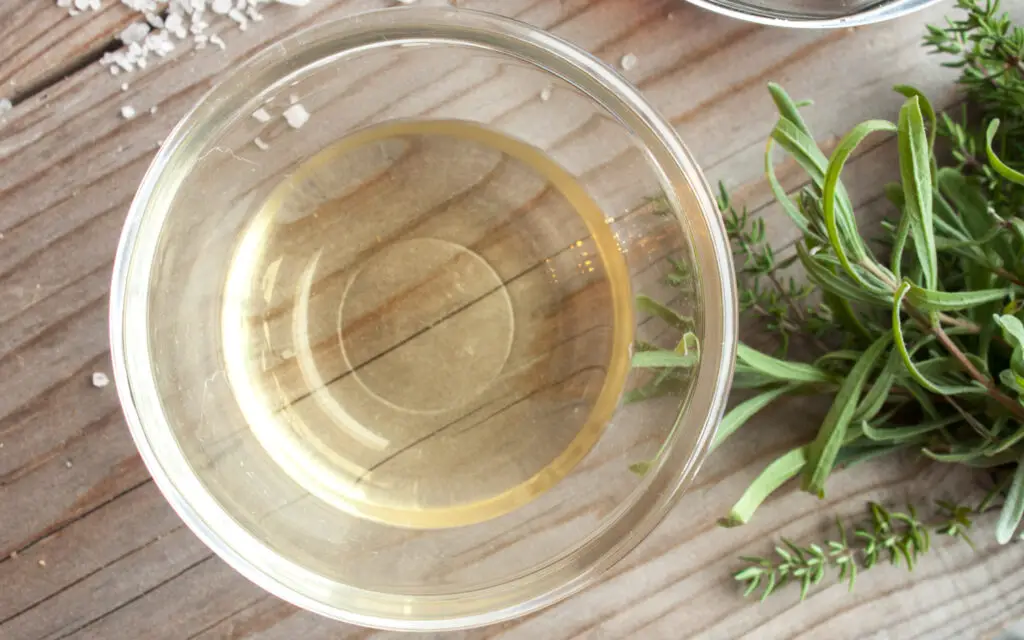
White wine vinegar is the perfect substitute for tarragon vinegar and offers a pleasant, mild acidic taste to salads.
It’s created by allowing white wine to ferment until it becomes acetic acid and forms an aromatic, clear liquid.
White wine vinegar is an interesting and tasty replacement for tarragon vinegar but it can also be used in other recipes such as marinades and sauces.
It works especially well in cold dishes like dressings and dips, where the acidity adds just the right amount of tangy flavor.
White wine vinegar makes a great all-purpose ingredient due to its affordability, availability, high acidity, and subtly sweet flavor.
Related: 12 Substitutes for Dark Soy Sauce
Apple Cider Vinegar
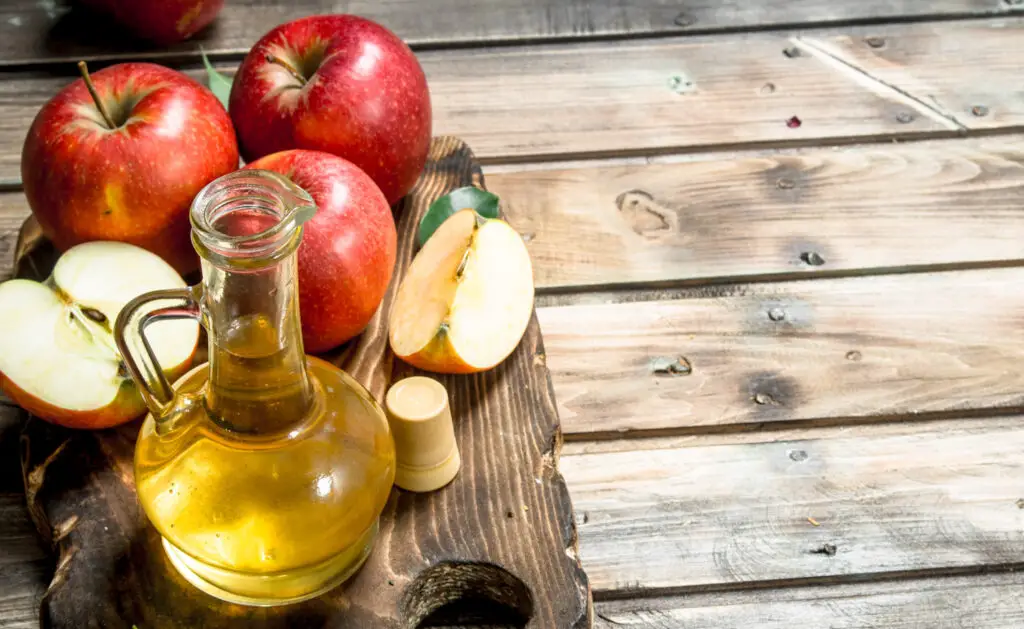
Apple Cider Vinegar is a great substitute for tarragon vinegar, providing a slightly sweet and tangy flavor to any dish.
It is the perfect replacement when you’re in a pinch and don’t have access to tarragon vinegar.
Apple cider vinegar works especially well in dressings, marinades, and other sauces, adding subtle complexity and brightening the flavor profile.
If you’re looking for an alternative to tarragon vinegar that won’t disappoint you, try switching it up with apple cider vinegar.
Champagne Vinegar
Champagne vinegar is one of the best tarragon vinegar substitutes.
Unlike tarragon vinegar, champagne vinegar is a mild, light, and fruity alternative made by fermenting champagne.
It has subtle floral and nutty hints of flavor which match perfectly with salads and sauces.
A tablespoon of this champagne vinegar can also reduce the intensity of some meats, making it an ideal substitute for tarragon vinegar in recipes.
This ‘champagne of vinegar’ is low in sodium and acidity compared to other vinegar, making it a healthier option.
It provides an overall tartness that does not overpower the dish but leaves a subtle yet distinct taste behind.
Champagne vinegar is versatile and creates a unique flavor profile.
Related: 9 Creative Substitutes for Asparagus
Balsamic Vinegar
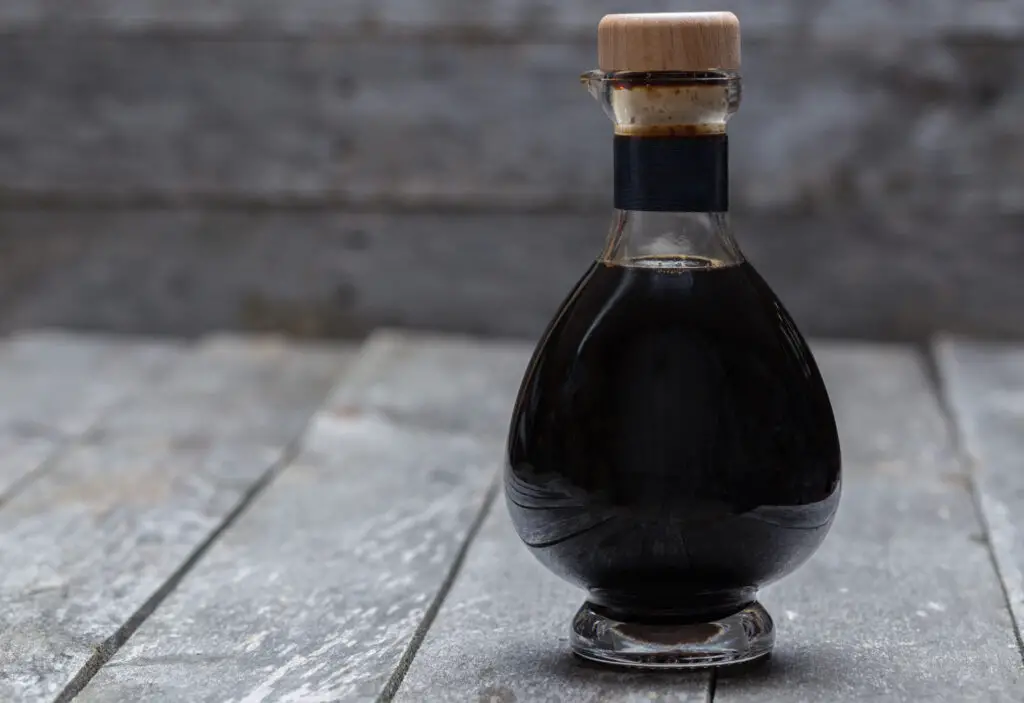
Balsamic vinegar is a great tarragon vinegar substitute in many recipes.
It provides a classic sweet-tart flavor that perfectly pairs perfectly with salads, marinades, sauces, and other dishes.
The distinctive flavor of balsamic vinegar comes from its aging process, which can take up to 12 years or more to produce the final product.
This aged fruit vinegar also contains various flavorful compounds that perfectly complement almost any dish.
Instead of the herby taste that comes with tarragon vinegar, balsamic has fruity and tart notes that give any meal an unmistakably delicious finish.
Red Wine Vinegar

Another substitute for tarragon vinegar is red wine vinegar.
It can add the perfect depth of flavor and acidity to any dish.
With a fruity yet bold flavor, red wine vinegar adds robustness to salads and marinades while enhancing dishes.
Perfectly paired with roasted vegetables, meat dishes, and sauces, it will take your recipes up a notch while bringing out the best in your ingredients.
Rice Vinegar
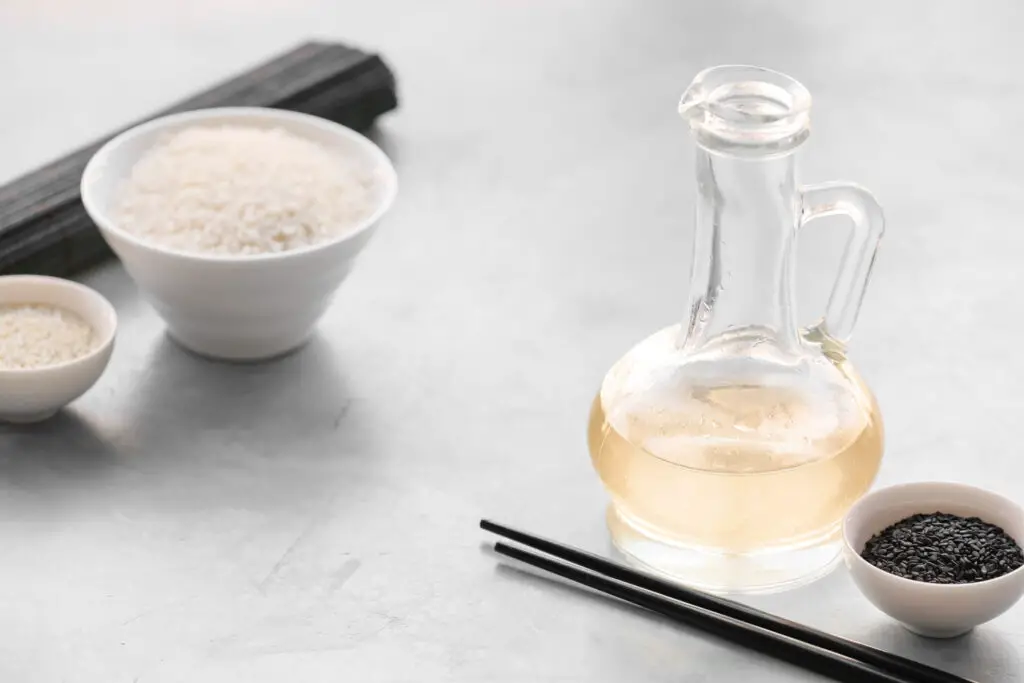
Rice vinegar is a popular substitute for tarragon vinegar, with its own unique flavor profile.
Not only is it tart and slightly sweet, but it also has a slightly nutty taste that can be used to give certain vegetable dishes a deliciously savory hint.
It also tends to be much milder than other vinegar and has little to no pungency.
Rice vinegar, made with fermented rice, is also perfect for marinating meats since its lightness won’t overpower the savory flavors of roasted meat.
Additionally, rice vinegar has enough acidity to kick up recipes like salads and vegetables without being overly sharp or bitter.
With its slight sweetness and rich undertones, rice vinegar can quickly become an indispensable pantry staple.
Malt Vinegar

Malt vinegar is a type of vinegar made from barley and other grains that are left to steep and then distilled.
The result is a pale yellow liquid with a pleasant, sour taste.
Its mild flavor profile has hints of maltiness, sweetness, and smokiness, making it a great substitute for tarragon vinegar.
As tarragon vinegar can be difficult to source in some areas, malt vinegar is an excellent substitution.
It can help recreate the balance of herbal notes and acidity characteristic of fresh tarragon leaves while adding its own unique flavors.
Malt vinegar is perfect for vinaigrettes, marinades, sauces, or just sprinkled over chips – relatively inexpensive and easy to find; it adds complexity and depth to dishes without the hassle of tracking down more obscure ingredients.
Related: 5 Substitutes for Galangal to Spice up Your Cooking
Lemon Juice
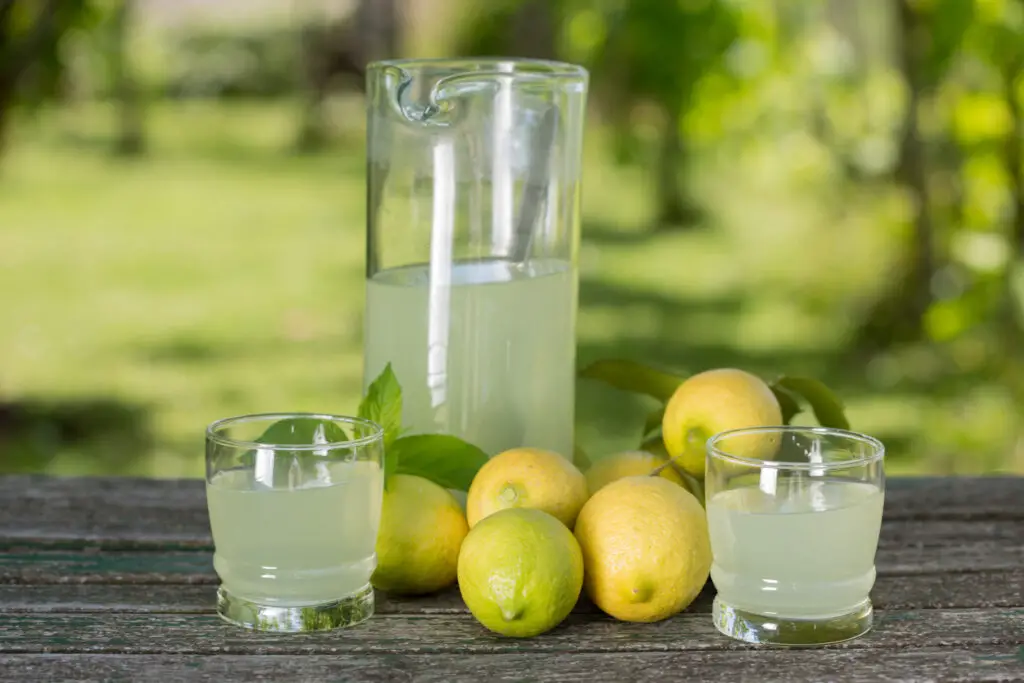
Lemon juice is a refreshingly tart and versatile tarragon vinegar substitute.
It can be used in place of tarragon vinegar in various dishes, adding its distinct citrus flavor to salads, sauces, marinades, and more.
In addition to its fresh and sour flavor, lemon juice offers numerous nutritional benefits.
It is a natural source of vitamin C and antioxidants that can help boost your immune system.
For those looking for an inexpensive option to add some extra zing to their recipes, lemon juice is an ideal choice that pairs well with any number of flavors.
Sherry Vinegar
Sherry vinegar is an excellent tarragon vinegar substitute as it has a golden-brown color and sweet flavor that complements the bright acidity of tarragon vinegar.
With a complex blend of fragrances consisting of freshness and fruitness, sherry vinegar offers complementary elements that pair nicely with many dishes.
What makes it so special is the amazing nuttiness derived from the careful aging process in oak barrels.
This method creates layers of smokiness and woody aromas, which further add to its unique character.
In short, it has many characteristics that make it perfect when used to substitute tarragon vinegar in marinades, sauces, and salad dressing.
Homemade Tarragon Vinegar
Making tarragon vinegar at home is a great way to save money and add delicious tarragon flavor to your meals!
All you need is white vinegar, dried tarragon, and an air-tight container.
Start by filling the container three-quarters of the way with white vinegar, then add a handful of dried tarragon leaves. Fennel seeds would also work well.
Seal the container and store it in a cool, dark place for two weeks.
After two weeks have passed, strain and discard the tarragon leaves and transfer the liquid into a clean bottle with a lid.
When used in salad dressings or marinades, homemade tarragon vinegar adds just enough sweetness to make dishes stand out.
When making your own tarragon vinegar, it is possible to use fresh tarragon in this homemade vinegar recipe, but the flavor won’t be as strong.
Best of all, unlike store-bought varieties, you know exactly what is in your DIY tarragon vinegar – nothing but food-grade vinegar and all-natural tarragon herbs!
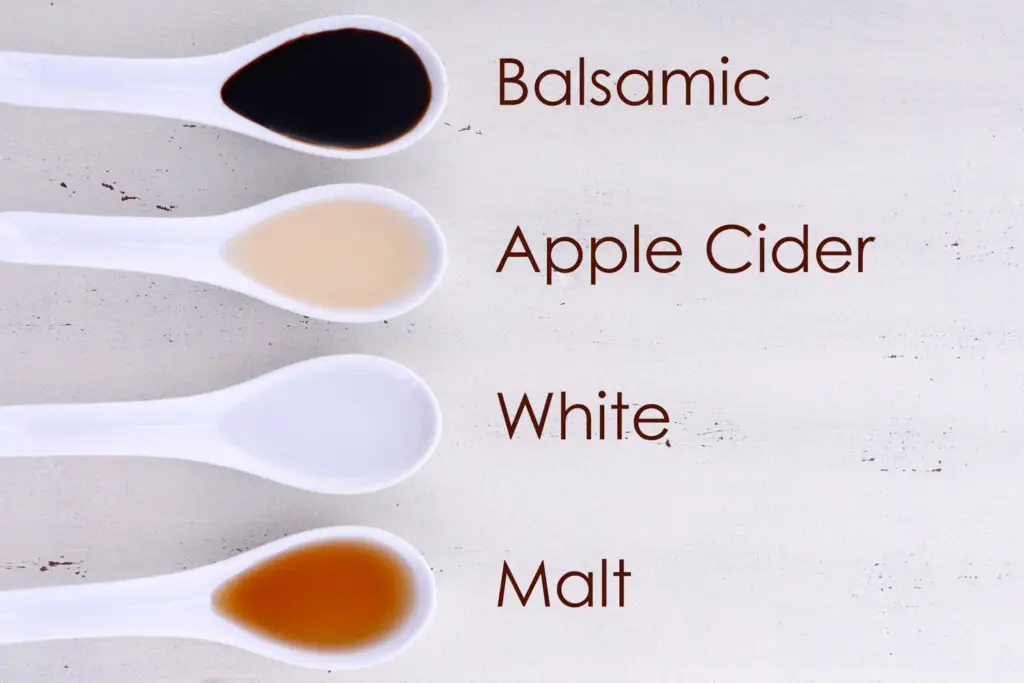
Summary – Best Tarragon Vinegar Substitute
This concludes our look at the best substitutes for tarragon vinegar.
All in all, replacing tarragon vinegar can be an easy way to switch up the flavor of your favorite recipes.
From a range of vinegar, such as white wine vinegar and balsamic vinegar, to lemon juice, the above tarragon vinegar substitutes will provide sweet, tart, or nutty flavors without the taste of tarragon.
FAQ
What is a Fresh Tarragon Substitute?
When a recipe calls for tarragon, you may find yourself out of luck if you don’t have any in your pantry. But all is not lost! You can substitute many other fresh herbs that offer a similar flavor to tarragon and still get deliciously flavorful results.
Parsley or chervil are two of the most commonly suggested alternatives to fresh tarragon; chives condensed into a paste also work as a good replacement.
For an even more intense flavor, try basil or dill with a splash of white wine vinegar.
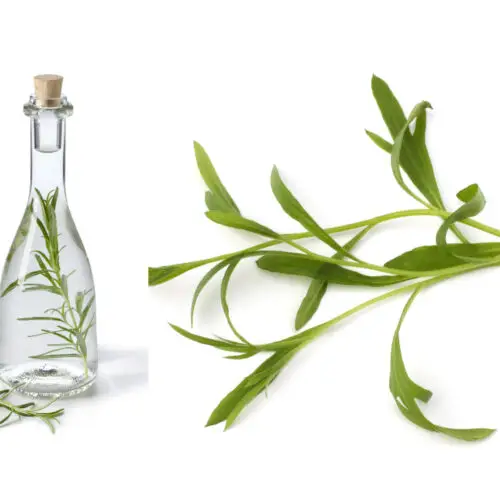
9 Substitutes for Tarragon Vinegar
Ingredients
- White Wine Vinegar
- Apple Cider Vinegar
- Champagne Vinegar
- Balsamic Vinegar
- Red Winne Vinegar
- Rice Vinegar
- Malt Vinegar
- Lemon Juice
- Homemade Tarragon Vinegar
Instructions
- Decide on the type of substitute for Tarragon Vinegar you need based on texture and flavor.
- Pick the best fit from the above list of substitutes.
- Add to the recipe the proportions required to match the flavor and texture of the Tarragon Vinegar.

